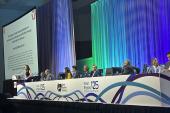BIO-LIBRA: Outcomes Vary by Sex, Device in Cardiomyopathy Patients With ICDs
Though women have a lower risk of ventricular arrhythmias than do men, it still exceeds the threshold to justify a device.

SAN DIEGO, CA—The observational BIO-LIBRA study, which enrolled nearly 50% women, has revealed important outcome differences by both sex and device type among patients with nonischemic cardiomyopathy and implanted defibrillators.
Women were less likely than men to develop ventricular tachycardia or fibrillation (VT/VF) and to receive inappropriate shocks from their devices over 3 years follow-up, while patients with a cardiac resynchronization therapy-defibrillator (CRT-D) had a lower rate of VT/VF or death compared with those who had an implantable cardioverter-defibrillator (ICD).
BIO-LIBRA principal investigators Valentina Kutyifa, MD, PhD (University of Rochester Medical Center, NY), and Jeanne Poole, MD (UW Medicine, Seattle, WA), who reported the findings recently at Heart Rhythm 2025, said the study shows that it’s possible to increase enrollment in an ICD/CRT study and to generate sex-specific data. Female leadership and female-focused study materials helped in this regard.
The latest guidelines on the prevention of sudden cardiac death from the US and Europe do not distinguish between women and men in their recommendations for patients with nonischemic cardiomyopathy, pointed out Laurent Macle, MD (Montreal Heart Institute, Canada), the discussant following the presentation.
“This is an important point because the benefit of ICDs in women has been questioned over the past years and, unfortunately, none of the RCTs of primary prevention ICD in that population involved enough women to address this issue,” he said.
BIO-LIBRA, though not a randomized trial, enrolled more women than any of the prior trials on which the recommendations are based. Macle noted that in the study, even though women had about half the risk of VT/VF seen in men, “it remained a 3% annual risk of this significant arrhythmia, well above the threshold justifying a defibrillator in that population.”
The BIO-LIBRA Study
A more recent trial, DANISH, showed that ICD therapy, with or without CRT, did not reduce overall mortality—but did reduce sudden cardiac death—in patients with nonischemic cardiomyopathy.
Women have been underrepresented in all these trials, however.
The aim of the observational BIO-LIBRA study was to examine contemporary outcomes of patients with nonischemic cardiomyopathy and a guideline indication for a primary prevention ICD or CRT-D, with a key goal of having women make up more than 40% of the cohort. The investigators enrolled 1,000 patients (mean age 62 years) who underwent successful implantation of a Biotronik ICD or CRT-D across 48 US sites. Nearly half of participants (48%) and 25% of site PIs were women.
Through 3 years of follow-up, there were high residual risks of the composite of ventricular arrhythmias or death (21%), VT/VF (14%), and all-cause death (12%) despite high compliance with GDMT for heart failure. At baseline, 92% of participants were taking a beta-blocker, 80% an ACE inhibitor, ARB, or angiotensin receptor-neprilysin inhibitor (ARNI), 75% a diuretic, 39% a mineralocorticoid receptor antagonist, and 6% a sodium-glucose cotransporter 2 (SGLT2) inhibitor (although that increased to 20% at 3 years).
Women had a significantly lower rate of ventricular arrhythmias or death compared with men (17% vs 28%; adjusted HR 0.70; 95% CI 0.52-0.96), driven by a significantly lower rate of VT/VF (9% vs 18%; adjusted HR 0.53; 95% CI 0.35-0.81). After accounting for potential confounders, all-cause mortality was not significantly lower compared with men (9% vs 14%; adjusted HR 0.92; 95% CI 0.60-1.41).
The composite outcome of ventricular arrhythmias or death also occurred less frequently in patients with a CRT-D versus an ICD (18% vs 27%; adjusted HR 0.70; 95% CI 0.51-0.98), although there were no significant differences between device types of the individual outcomes of VT/VF (10% vs 17%; adjusted HR 0.69; 95% CI 0.46-1.04) or all-cause death (11% vs 13%; adjusted HR 0.86; 95% CI 0.56-1.33).
During follow-up, 6.1% of patients had an appropriate shock, with no differences by sex or device type. The rate of inappropriate shocks was higher, at 10.3%, and these were less common in women and patients with a CRT-D.
The rate of sudden cardiac death was 1.4%; these events accounted for 12.7% of all deaths. Another 43% of deaths were related to cardiac causes.
Eyeing Better Selection for ICD Therapy
The landmark ICD trials were performed in an era when optimal medical therapy for heart failure didn’t include ARNIs or SGLT2 inhibitors, Macle noted, adding that both drug classes have been associated with significant reductions of sudden cardiac death. BIO-LIBRA showed that ARNIs and SGLT2 inhibitors continued to be underused, he said. Another key finding, he added, is that about 85% of patients didn’t receive a shock from their device.
“The question is: can we better select men and women with nonischemic cardiomyopathy that are receiving optimal heart failure therapy for primary prevention ICD?” Macle said.
Commenting for TCTMD, Dhanunjaya Lakkireddy, MD (Kansas City Heart Rhythm Institute and Research Foundation, Overland Park, KS), abstract chair for the Heart Rhythm Society, said BIO-LIBRA “reflects that there is still a little bit of nuance in terms of—in the nonischemic cardiomyopathy patients—whether the bang for the buck with the device is there or not.”
He believes an overall survival benefit still exists, saying that BIO-LIBRA helps fill a gap in the literature since there haven’t been any large studies in the ICD space for several years.
It’s likely ICDs will continue to provide a benefit even in more contemporary cohorts receiving ARNIs and SGLT2 inhibitors, Lakkireddy said. Those medications, which should be started whenever possible, will probably help boost LVEF and overall heart function, he said, “but then we really don’t take away the underlying risk of scar-mediated arrhythmias and the potential arrhythmic deaths that come from that.”
Still, BIO-LIBRA “points out the need for continued education for appropriate use of heart failure medications, especially the newest medications,” Poole said. “Undoubtedly, if we have populations that are well treated, maybe these [outcome] numbers will change and, in fact, decrease.”
Todd Neale is the Associate News Editor for TCTMD and a Senior Medical Journalist. He got his start in journalism at …
Read Full BioSources
Kutyifa V, Poole JE. BIO-LIBRA: contemporary outcomes of nonischemic cardiomyopathy patients with an implanted defibrillator or cardiac resynchronization defibrillator. Presented at: HRS 2025. April 26, 2025. San Diego, CA.
Disclosures
- BIO-LIBRA was supported by an investigator-initiated research grant from Biotronik to the University of Rochester Medical School, NY.
- Kutyifa reports research grants from Biotronik, Boston Scientific, the National Institutes of Health, Spire Inc, and Zoll and consulting fees from Abbott, Biotronik, Medtronic, and Zoll.
- Poole reports research grants from AtriCure, Biotronik, Boston Scientific, and Kestra Medical.
- Macle reports speaking and teaching for Abbott, Biosense Webster, Medtronic, and Servier.





Comments